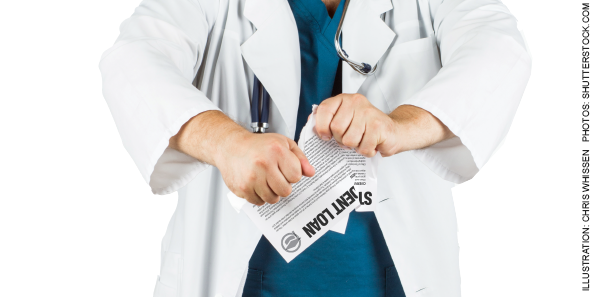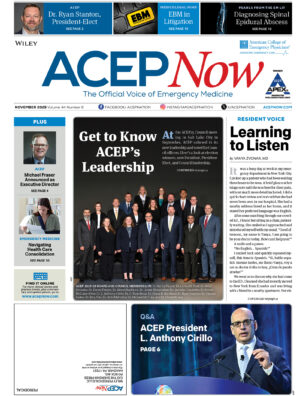
Q. I understand there’s a way to get my student loans forgiven if I work for a non-profit hospital. How does that work?
Explore This Issue
ACEP Now: Vol 37 – No 04 – April 2018A. You’re referring to the Public Service Loan Forgiveness (PSLF) program. This federal program allows you to have the remainder of your federal direct student loans forgiven, tax-free, if you make 120 monthly payments under an eligible payment plan while being employed full-time by the military, Veterans Administration, or a 501(c)3 employer (ie, a non-profit employer).
Eligible payment plans include the standard 10-year repayment plan along with three income driven repayment (IDR) programs: Income Based Repayment (IBR), Pay As You Earn (PAYE), and Revised Pay As You Earn (RePAYE). These IDR plans also have a forgiveness component to them, which doesn’t require you to work for a 501(c)3, but they require 20–25 years of payments, after which most emergency physicians (EPs) would have paid their loans off anyway. The amount forgiven is taxable. Thus, PSLF is really the only federal forgiveness program that most EPs should consider.
Most residency and fellowship programs qualify as non-profit employers, as do many academic positions and some community emergency physician positions. Bear in mind that working in a non-profit hospital doesn’t necessarily allow you to qualify. You must be an employee of the hospital, not a partner or employee of a private group that contracts with the hospital.
A typical EP with a typical medical school debt burden wouldn’t have any debt left to forgive after making 120 monthly payments under the standard 10-year repayment plan. The secret to actually receiving economic benefit under this program lies in enrolling in one of the other programs. PAYE and RePAYE have the lowest required payments—10 percent of discretionary income, which is defined as the difference between your income and 150 percent of the poverty line for your geographic area and family size. Note that the payments have nothing to do with the amount or interest rate of your debt. During residency, RePAYE is often the best program to enroll in because it may actually subsidize the loan, lowering your effective interest rate. PAYE is usually the best program after residency because, unlike RePAYE, it caps payments at the 10-year standard repayment plan amount.
The amount left to be forgiven after 10 years of payments turns out to be essentially the difference between what you would’ve paid under the standard repayment plan and what you did pay under an IDR plan. So, a typical medical student may graduate with $200,000 in debt, which grows to $250,000 during residency (IDR payments don’t even cover the interest on the debt). The student then pays it down to perhaps $150,000 as an attending, at which point the rest is forgiven. The more payments you make that are less than the standard payments, the more debt is left to be forgiven after 120 payments.
This leads doctors to use a few strategies to try to maximize the amount forgiven. First, some types of loans (eg, Federal Family Education Loans and Federal Perkins Loans) don’t qualify for forgiveness unless they are consolidated into a Federal Direct Loan. Second, you can enroll in an IDR program and start making payments late in your fourth year of medical school, essentially increasing the percentage of payments you make while your income, and thus your payments, remain low. Third, contributing to tax-deferred retirement accounts during residency further lowers your income and your required payments. Finally, some physicians married to high earners find it advantageous to file their taxes as “married filing single” while enrolled in an IDR program. Even though this often increases their combined tax burden, it can also reduce the borrower’s income (at least in the IBR and PAYE programs) and thus their spouse’s required payments.
A longer training period can also help maximize forgiveness. A physician who spends seven years in residency and fellowship may need to make full payments for only three years as an attending before receiving forgiveness.
Private student loans are never eligible for PSLF, and the best strategy for managing those usually involves refinancing to a lower rate as soon as possible (usually shortly after medical school graduation) and paying them off early in your career. Several lenders allow very low payments during training, just like the federal IDR programs.
Caution: Refinancing your federal direct loans can be a big mistake if you later end up working for a 501(c)3 after residency graduation. Another common error is putting your loans into forbearance or deferment during training, which prevents the accumulation of lower IDR payments that would later allow for significant forgiveness under PSLF. If you make IDR payments throughout residency and work full-time for a 501(c)3 after residency, going for PSLF instead of refinancing the loans generally works out better mathematically than refinancing, even if the interest rate is higher.
Many students, residents, and attendings worry Congress will change the rules and take PSLF away. That is a significant risk—both the Obama Budget of 2013 and the Trump Budget of 2018 proposed doing away with the program as we know it. The Prosper Act, currently in House committee, would also cause significant changes to the federal loan programs if it becomes law in its current form.
However, in the past, when federal student loan programs were changed, those currently in the program were usually grandfathered into the old program. A good way to hedge this legislative risk is to make large student loan payments as an attending that would allow you to pay off your loans within two to five years after residency completion, but make those payments to your own investing account. Then, if something happens to PSLF, you can simply take those funds and pay off the loans. If you do receive forgiveness, you can use that money to bolster your retirement nest egg or other savings goals.
Some worry about the morality of not paying back borrowed money when you have the means to do so. My response? Hate the game, not the player. I see loan forgiveness no differently than using a tax-advantaged retirement savings account or taking the child tax credit. We have no duty to leave money on the table that we legally qualify for, even if we disagree with federal student loan policy.
Since PSLF was instituted in 2007, the first borrowers are just now starting to receive forgiveness after making their 120 monthly payments. As the years go by, you’ll see more and more physicians receiving this federal benefit. Managing your student loans well will increase your financial security and allow you to take better care of your family and patients.
Pages: 1 2 3 | Multi-Page






No Responses to “How to Receive Student Loan Forgiveness”